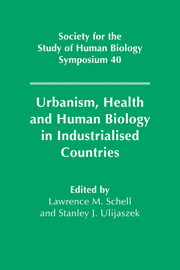Book contents
- Frontmatter
- Contents
- List of contributors
- Part I The urban environment
- Part II Epidemiology
- 5 Emerging infectious diseases: biology and behavior in the inner city
- 6 Fecundity and ovarian function in urban environments
- 7 Pollution and child health
- 8 Urbanism and health in industrialised Asia
- Part III Poverty and health
- Part IV Behavior and stress
- Part V The future
- Index
6 - Fecundity and ovarian function in urban environments
Published online by Cambridge University Press: 06 January 2010
- Frontmatter
- Contents
- List of contributors
- Part I The urban environment
- Part II Epidemiology
- 5 Emerging infectious diseases: biology and behavior in the inner city
- 6 Fecundity and ovarian function in urban environments
- 7 Pollution and child health
- 8 Urbanism and health in industrialised Asia
- Part III Poverty and health
- Part IV Behavior and stress
- Part V The future
- Index
Summary
Editors' introduction
The future of the human species is dependent on reproductive ecology, so it is logical for us to want to know how reproduction is affected by features of urban life, both old and new. Ellison makes it clear that past ecological transitions, from foraging to agriculture, and from agriculture to industrialisation, altered reproductive ecology dramatically. Both transitions involved changes in residential pattern that are part of urbanisation. The post-industrial city also can have an impact, and Ellison describes several mechanisms and pathways, termed “proximate determinants,” by which urban factors can influence parameters of reproductive function, specifically ovarian function. Population density per se is not the salient factor, but urbanism includes behaviors that can affect ovarian function. Among these are urban patterns of maturation and aging, anxiety, dietary composition, pollutants, as well as energy expenditure and energy balance, a topic that Ulijaszek also addresses in chapter 13. Although most of these factors are not unique to cities, they may be more varied there and so make a stronger contribution to variation in ovarian function. By recognising that cities are not a unitary phenomenon but show great variation, the focus turns towards identifying the specific determinants of ovarian function. The ability to define these determinants depends on their accurate measurement.
- Type
- Chapter
- Information
- Urbanism, Health and Human Biology in Industrialised Countries , pp. 111 - 135Publisher: Cambridge University PressPrint publication year: 1999



